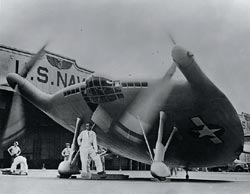|
The basic wing area (427 sq ft.) and planform (less ailevators and propeller nacelles) of the V-173 and XF5U-1 were identical. The airfoil was the NACA 0015 section on the V-173 and the NACA 0018 section on the XF5U-1. Two Continental A-80 engines, rated at 80-horsepower each, turned two 16.5-foot three-bladed propellers on the V-173. The aircraft had long fixed main landing gear and a 22-degree nose-high static ground angle. Wheel fairings were added after the first flight. The pilot cockpit enclosure had a windowed leading edge ahead of the pilot for down vision, and four segmented leading edge inlets (left and right) for engine air.
For light weight, the airframe structure was made of wood with fabric covering. With a wing loading of only 5 lbs/sq ft, the V-173 could lift off in 200 feet in a calm, and with a zero run against a 25-knot headwind. However, with a power loading of 14-lbs/hp maximum, level flight speed was only 138 mph.
The pilot could enter or egress from the cockpit through a hatch in the cockpit floor or through a sliding canopy.
 The first flight was of only 13 minutes duration because of very heavy longitudinal stick forces, and having only 20 gallons of fuel aboard. The stick forces were subsequently lightened by adding the trailing-edge stability flaps and ailevator trim tabs. The airplane accumulated 131 hours in several hundred flights, many of which were flown to exhibit the outstanding STOL characteristics. Vought’s Chief experimental pilot, Boone T. Guyton, made 54 flights. Charles Lindbergh, who was a consultant to Chance Vought Aircraft, made one flight in the V-173. The first flight was of only 13 minutes duration because of very heavy longitudinal stick forces, and having only 20 gallons of fuel aboard. The stick forces were subsequently lightened by adding the trailing-edge stability flaps and ailevator trim tabs. The airplane accumulated 131 hours in several hundred flights, many of which were flown to exhibit the outstanding STOL characteristics. Vought’s Chief experimental pilot, Boone T. Guyton, made 54 flights. Charles Lindbergh, who was a consultant to Chance Vought Aircraft, made one flight in the V-173.
Guyton summed up his observations as:
- I was able to apply full power, raise the nose as high as it could be held, and have control about all three axes without stalling.
- The aircraft could not be completely stalled or even approach a spin condition.
- A notable characteristic was high deceleration in a tight turn due to the aspect ratio (drag due to lift), and low power loading.
- Engine- and propeller- related vibration showed the need for articulated (i.e., flapping) propellers.
When the Navy contract was canceled in 1947 the V-173 was placed in storage at Norfolk Naval Air Station. In 1961 it was moved to storage at the Smithsonian Institution’s Air Museum warehouse in Silver Hill, Maryland. The V-173 was transported to the Vought Aircraft Heritage Foundation facility in Dallas, Texas for restoration in 2003.
More V-173:
Advanced Design Concepts
The Aircraft
|